Fleurs du Mal Magazine


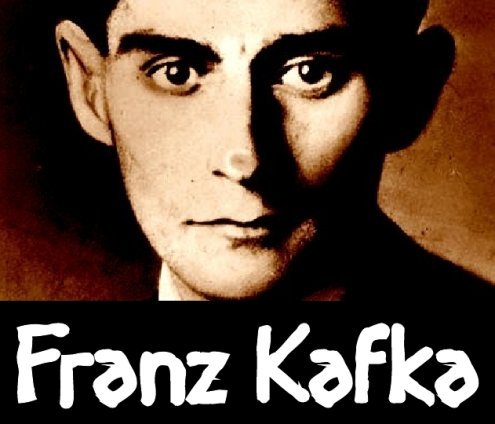
Zerstreutes Hinausschaun
Franz Kafka (1883-1924)
Was werden wir in diesen Frühlingstagen tun, die jetzt rasch kommen? Heute früh war der Himmel grau, geht man aber jetzt zum Fenster, so ist man überrascht und lehnt die Wange an die Klinke des Fensters. Unten sieht man das Licht der freilich schon sinkenden Sonne auf demGesicht des kindlichen Mädchens, das so geht und sich umschaut, und zugleich sieht man den Schatten des Mannes darauf, der hinter ihmrascher kommt.
Dann ist der Mann schon vorübergegangen und das Gesicht des Kindes ist ganz hell.

Franz Kafka: Betrachtung 1913 – Für M.B.
fleursdumal.nl magazine
More in: Franz Kafka, Kafka, Franz, Kafka, Franz
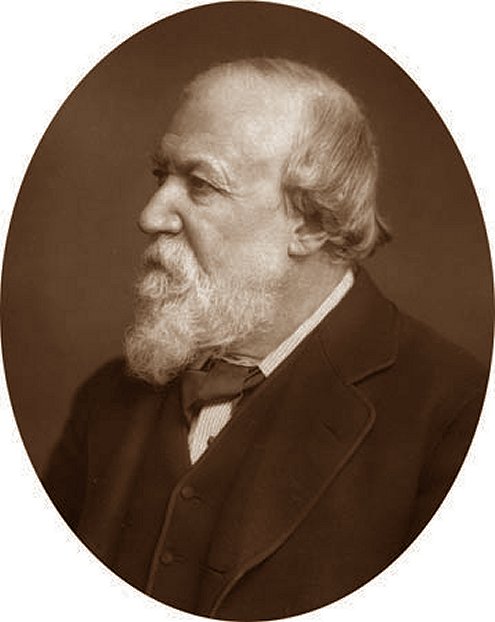
R o b e r t B r o w n i n g
(1812-1889)
I n T h r e e D a y s
So, I shall see her in three days
And just one night, but nights are short,
Then two long hours, and that is morn.
See how I come, unchanged, unworn!
Feel, where my life broke off from thine,
How fresh the splinters keep and fine–
Only a touch and we combine!
Too long, this time of year, the days!
But nights, at least the nights are short.
As night shows where her one moon is,
A hand’s-breadth of pure light and bliss,
So life’s night gives my lady birth
And my eyes hold her! What is worth
The rest of heaven, the rest of earth?
O loaded curls, release your store
Of warmth and scent, as once before
The tingling hair did, lights and darks
Outbreaking into fairy sparks,
When under curl and curl I pried
After the warmth and scent inside,
Through lights and darks how manifold–
The dark inspired, the light controlled!
As early Art embrowns the gold.
What great fear, should one say, “Three days
That change the world might change as well
Your fortune; and if joy delays,
Be happy that no worse befell!”
What small fear, if another says,
“Three days and one short night beside
May throw no shadow on your ways;
But years must teem with change untried,
With chance not easily defied,
With an end somewhere undescried.”
No fear!–or if a fear be born
This minute, it dies out in scorn.
Fear? I shall see her in three days
And one night, now the nights are short,
Then just two hours, and that is morn.
![]()
Robert Browning poetry
kempis poetry magazine
More in: Archive A-B, Browning, Robert
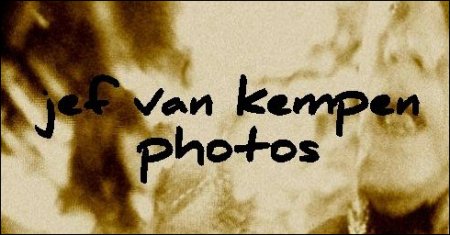

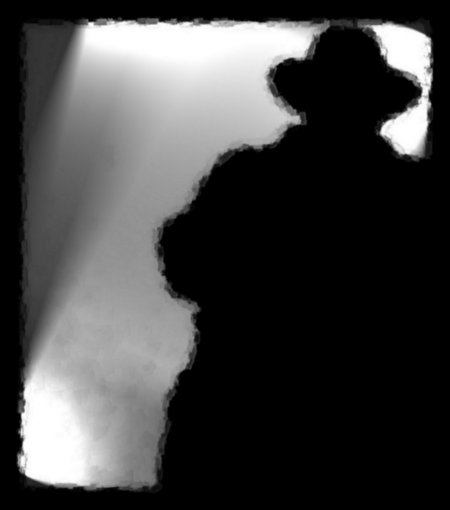

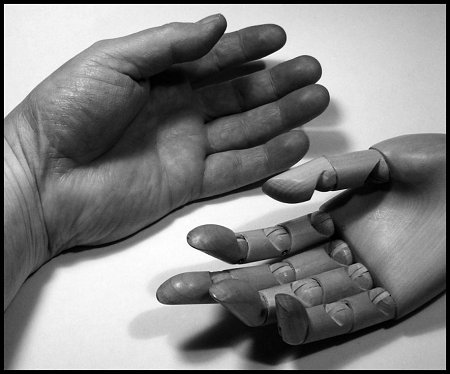

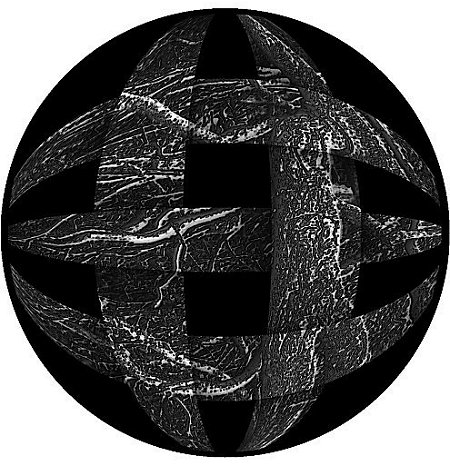

Jef van Kempen: 7 photos
fleursdumal.nl magazine
© fdm
w e b s i t e m u s e u m o f l o s t c o n c e p t s
More in: Dutch Landscapes, Jef van Kempen, Jef van Kempen Photos & Drawings, Kempen, Jef van

Alfred Lord Tennyson
(1809-1892)
The Lady of Shalott
Part I
On either side the river lie
Long fields of barley and of rye,
That clothe the wold and meet the sky;
And thro’ the field the road runs by
To many-tower’d Camelot;
And up and down the people go,
Gazing where the lilies blow
Round an island there below,
The island of Shalott.
Willows whiten, aspens quiver,
Little breezes dusk and shiver
Thro’ the wave that runs for ever
By the island in the river
Flowing down to Camelot.
Four gray walls, and four gray towers,
Overlook a space of flowers,
And the silent isle imbowers
The Lady of Shalott.
By the margin, willow-veil’d
Slide the heavy barges trail’d
By slow horses; and unhail’d
The shallop flitteth silken-sail’d
Skimming down to Camelot:
But who hath seen her wave her hand?
Or at the casement seen her stand?
Or is she known in all the land,
The Lady of Shalott?
Only reapers, reaping early
In among the bearded barley,
Hear a song that echoes cheerly
From the river winding clearly,
Down to tower’d Camelot:
And by the moon the reaper weary,
Piling sheaves in uplands airy,
Listening, whispers "’Tis the fairy
Lady of Shalott".
Part II
There she weaves by night and day
A magic web with colours gay.
She has heard a whisper say,
A curse is on her if she stay
To look down to Camelot.
She knows not what the ‘curse’ may be,
And so she weaveth steadily,
And little other care hath she,
The Lady of Shalott.
And moving thro’ a mirror clear
That hangs before her all the year,
Shadows of the world appear.
There she sees the highway near
Winding down to Camelot:
There the river eddy whirls,
And there the surly village-churls,
And the red cloaks of market girls,
Pass onward from Shalott.
Sometimes a troop of damsels glad,
An abbot on an ambling pad,
Sometimes a curly shepherd-lad,
Or long-hair’d page in crimson clad,
Goes by to tower’d Camelot;
And sometimes thro’ the mirror blue
The knights come riding two and two:
She hath no loyal knight and true,
The Lady of Shalott.
But in her web she still delights
To weave the mirror’s magic sights,
For often thro’ the silent nights
A funeral, with plumes and lights,
And music, went to Camelot:
Or when the moon was overhead,
Came two young lovers lately wed;
"I am half-sick of shadows," said
The Lady of Shalott.
Part III
A bow-shot from her bower-eaves,
He rode between the barley sheaves,
The sun came dazzling thro’ the leaves,
And flamed upon the brazen greaves
Of bold Sir Lancelot.
A redcross knight for ever kneel’d
To a lady in his shield,
That sparkled on the yellow field,
Beside remote Shalott.
The gemmy bridle glitter’d free,
Like to some branch of stars we see
Hung in the golden Galaxy.
The bridle bells rang merrily
As he rode down to Camelot:
And from his blazon’d baldric slung
A mighty silver bugle hung,
And as he rode his armour rung,
Beside remote Shalott.
All in the blue unclouded weather
Thick-jewell’d shone the saddle-leather,
The helmet and the helmet-feather
Burn’d like one burning flame together,
As he rode down to Camelot.
As often thro’ the purple night,
Below the starry clusters bright,
Some bearded meteor, trailing light,
Moves over still Shalott.
His broad clear brow in sunlight glow’d;
On burnish’d hooves his war-horse trode;
From underneath his helmet flow’d
His coal-black curls as on he rode,
As he rode down to Camelot.
From the bank and from the river
He flashed into the crystal mirror,
"Tirra lirra," by the river
Sang Sir Lancelot.
She left the web, she left the loom;
She made three paces thro’ the room,
She saw the water-lily bloom,
She saw the helmet and the plume,
She look’d down to Camelot.
Out flew the web and floated wide;
The mirror crack’d from side to side;
"The curse is come upon me," cried
The Lady of Shalott.
Part IV
In the stormy east-wind straining,
The pale yellow woods were waning,
The broad stream in his banks complaining,
Heavily the low sky raining
Over tower’d Camelot;
Down she came and found a boat
Beneath a willow left afloat,
And round about the prow she wrote
‘The Lady of Shalott.’
And down the river’s dim expanse–
Like some bold seer in a trance,
Seeing all his own mischance–
With a glassy countenance
Did she look to Camelot.
And at the closing of the day
She loosed the chain, and down she lay;
The broad stream bore her far away,
The Lady of Shalott.
Lying, robed in snowy white
That loosely flew to left and right–
The leaves upon her falling light–
Thro’ the noises of the night
She floated down to Camelot;
And as the boat-head wound along
The willowy hills and fields among,
They heard her singing her last song,
The Lady of Shalott.
Heard a carol, mournful, holy,
Chanted loudly, chanted lowly,
Till her blood was frozen slowly,
And her eyes were darken’d wholly,
Turn’d to tower’d Camelot;
For ere she reach’d upon the tide
The first house by the water-side,
Singing in her song she died,
The Lady of Shalott.
Under tower and balcony,
By garden-wall and gallery,
A gleaming shape she floated by,
Dead-pale between the houses high,
Silent into Camelot.
Out upon the wharfs they came,
Knight and burgher, lord and dame,
And round the prow they read her name,
‘The Lady of Shalott’
Who is this? and what is here?
And in the lighted palace near
Died the sound of royal cheer;
And they cross’d themselves for fear,
All the knights at Camelot:
But Lancelot mused a little space;
He said, "She has a lovely face;
God in his mercy lend her grace,
The Lady of Shalott".
.jpg)
Alfred Lord Tennyson poetry
k e m p i s p o e t r y m a g a z i n e

John William Waterhouse: The Lady of Shalott
More in: Tennyson, Alfred Lord
.jpg)
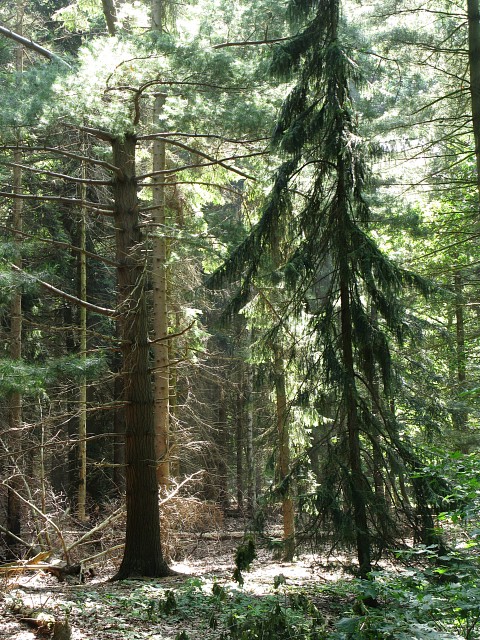
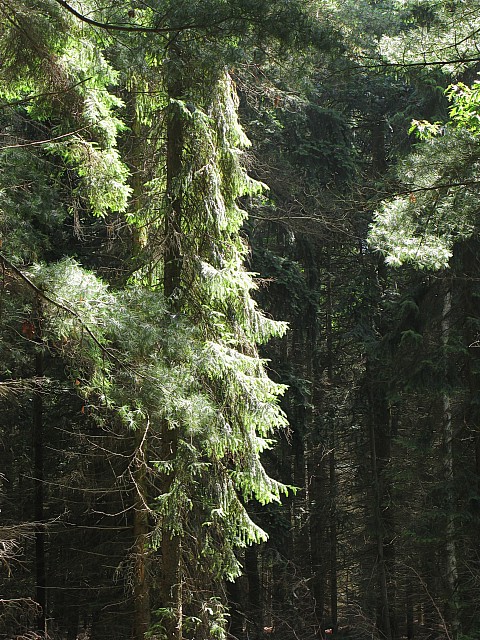
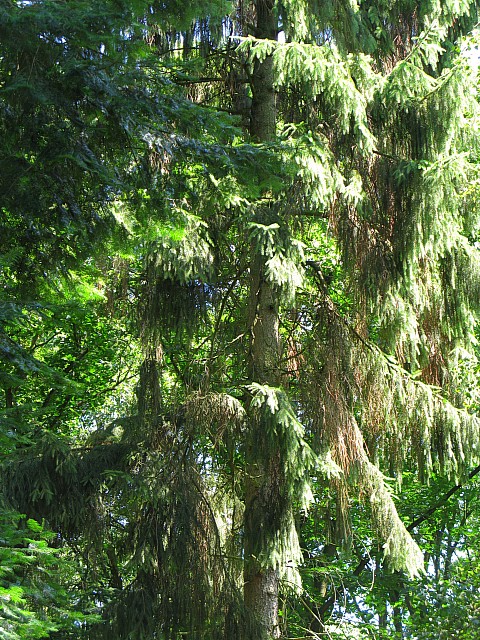

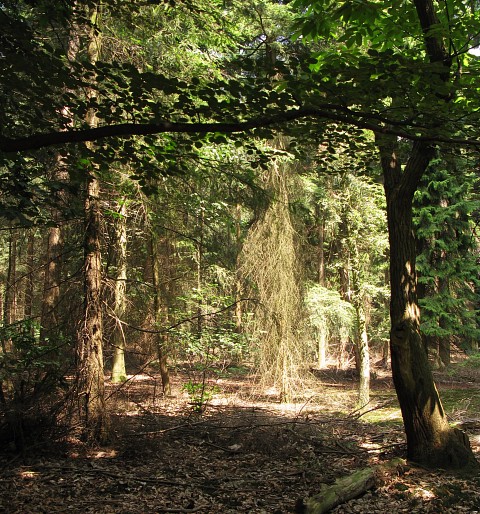

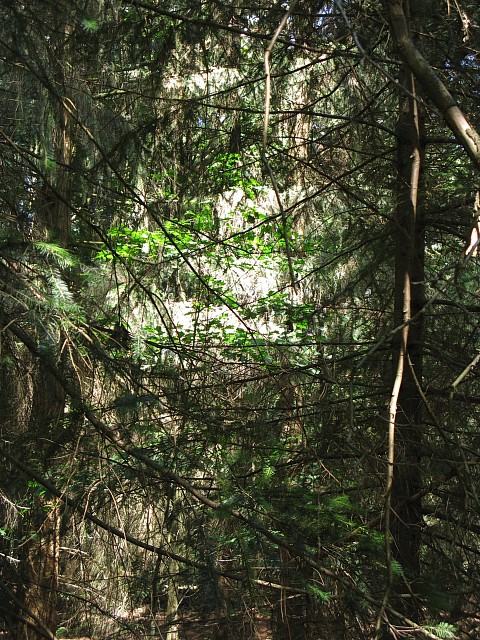


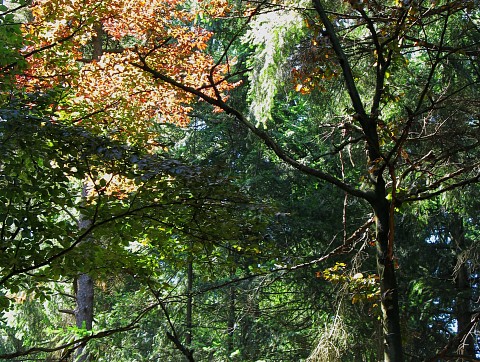
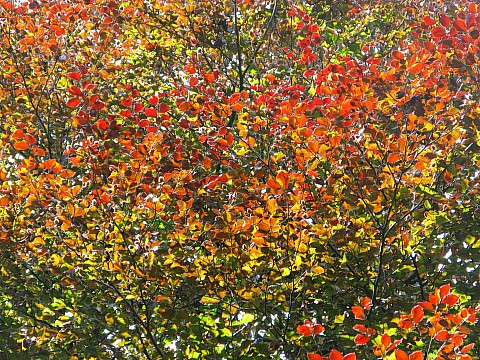
A n t o n K. p h o t o s : L i g h t – 2 –
(Oude Warande Tilburg NL)
fleursdumal.nl magazine
More in: Anton K. Photos & Observations, Dutch Landscapes
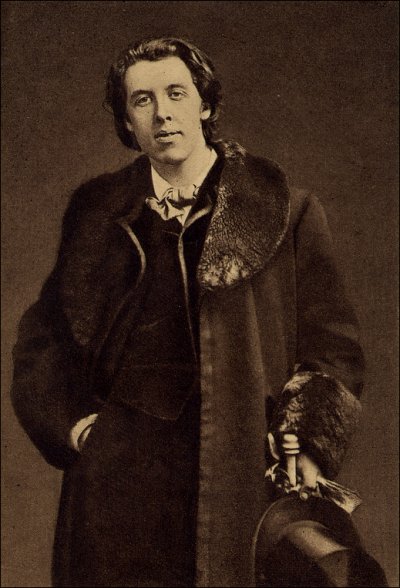
O s c a r W i l d e
(1854-1900)
The New Remorse
The sin was mine; I did not understand.
So now is music prisoned in her cave,
Save where some ebbing desultory wave
Frets with its restless whirls this meagre strand.
And in the withered hollow of this land
Hath Summer dug herself so deep a grave,
That hardly can the leaden willow crave
One silver blossom from keen Winter’s hand.
But who is this who cometh by the shore?
(Nay, love, look up and wonder!) Who is this
Who cometh in dyed garments from the South?
It is thy new-found Lord, and he shall kiss
The yet unravished roses of thy mouth,
And I shall weep and worship, as before.

Oscar Wilde poetry
k e m p i s p o e t r y m a g a z i n e
More in: Wilde, Oscar
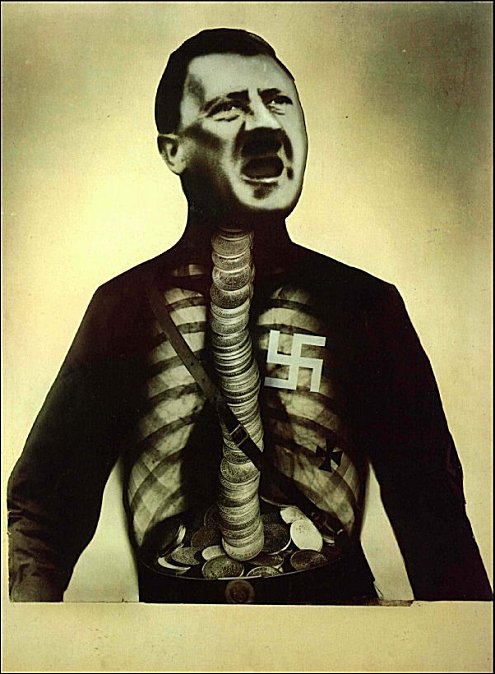
MUSEUM DE FUNDATIE ZWOLLE
John Heartfield (1891-1968)
Fotografie als wapen
20 september 2009 t/m 3 januari 2010
Zeventig jaar na het uitbreken van de Tweede Wereldoorlog en vierendertig jaar na de laatste grote expositie van zijn werk in Nederland toont Museum de Fundatie een omvangrijke selectie uit het eigenzinnige oeuvre van de Duitse kunstenaar John Heartfield. Heartfield, politiek geëngageerd kunstenaar en vlijmscherp satiricus, werd in 1891 in Berlijn geboren als Helmut Herzfeld. Hij veranderde in 1916 zijn naam in John Heartfield. Heartfield trad toe tot de Berlijnse tak van de dada-beweging en maakte kennis met de kunstenaar George Grosz.

De samenwerking met Grosz leidde in 1916 tot de door hen geclaimde uitvinding van de fotomontage, het combineren van bestaande foto’s in één beeld. In de jaren twintig ontwikkelde Heartfield de fotomontage tot een uiterst effectief propagandistisch strijdmiddel. Tussen 1930 en 1938 maakte hij montages voor het communistische weekblad Arbeiter Illustrierte Zeitung (AIZ). Deze vormen het hoogtepunt van Heartfields kunstenaarschap en zijn het resultaat van een jarenlange ontwikkeling op artistiek en politiek gebied.
De expositie Fotografie als wapen laat zien hoe de beeldende kunst aan de ene kant kan functioneren als ceremoniemeester van de macht en aan de andere kant een wapen kan zijn in de strijd tegen onrecht. De strijd die Heartfield in de jaren dertig heeft gevoerd tegen het opkomend nationaal-socialisme en vóór het communisme is een verhaal van grote persoonlijke moed en een reuzentalent om datgene te verbeelden wat het voorstellingsvermogen van zijn tijdgenoten ver te boven ging. Op de tentoonstelling ligt de nadruk op de fotomontages die Heartfield maakte voor de AIZ. Daarnaast zijn er ook werken te zien uit zijn dada-periode, alsmede boekontwerpen voor Malik Verlag en – hier voor het eerst getoond! – een reeks fotomontages uit Heartfields periode als balling in Londen. De expositie is tot stand gekomen in nauwe samenwerking met de Akademie der Künste in Berlijn, waar de nalatenschap van John Heartfield wordt bewaard.
fleursdumal.nl magazine
More in: Dada

V i c t o r H u g o
(1802-1885)
Le crucifix
[…] La flagellation du Christ n’est pas finie.
Tout ce qu’il a souffert dans sa lente agonie,
Au mont des Oliviers et dans les carrefours,
Sous la croix, sur la croix, il le souffre toujours.
Après le Golgotha, Jésus, ouvrant son aile,
A beau s’être envolé dans l’aurore éternelle,
Il a beau resplendir, superbe et gracieux,
Dans la tranquillité sidérale des cieux,
Dans la gloire, parmi les archanges solaires,
Au-dessus des douleurs, au-dessus des colères,
Au-dessus du nuage âpre et confus des jours ;
Chaque fois que sur terre et dans nos temples sourds
Et dans nos vils palais, des docteurs et des scribes
Versent sur l’innocent leurs lâches diatribes,
Chaque fois que celui qui doit enseigner, ment,
Chaque fois que d’un traître il jaillit un serment,
Chaque fois que le juge, après une prière,
Jette au peuple ce mot : Justice ! et, par derrière,
Tend une main hideuse à l’or mystérieux,
Chaque fois que le prêtre, époussetant ses dieux,
Chante au crime hosanna, bat des mains aux désastres,
Et dit : gloire à César ! là-haut, parmi les astres,
Dans l’azur qu’aucun souffle orageux ne corrompt,
Christ frémissant essuie un crachat sur son front.
– Torquemada, j’entends le bruit de ta cognée ;
Tes bras sont nus, ta face est de sueur baignée ;
A quoi travailles-tu seul dans ton noir sentier ? –
Torquemada répond : – Je suis le charpentier
Et j’ai la hache au poing dans ce monde où nous sommes.
– Qu’est-ce donc que tu fais ? – Un bûcher pour les hommes.
– Avec quel bois ? – Avec la croix de Jésus-Christ. –
[…]
.jpg)
Victor Hugo poésie
fleursdumal.nl magazine
More in: Archive G-H, Archive G-H, Hugo, Victor, Victor Hugo
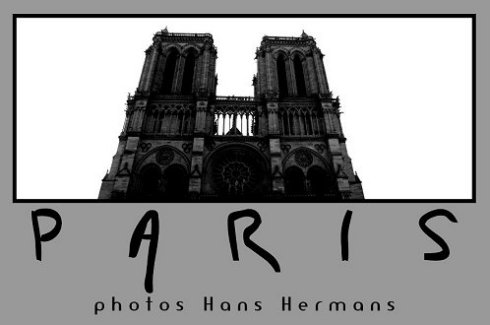
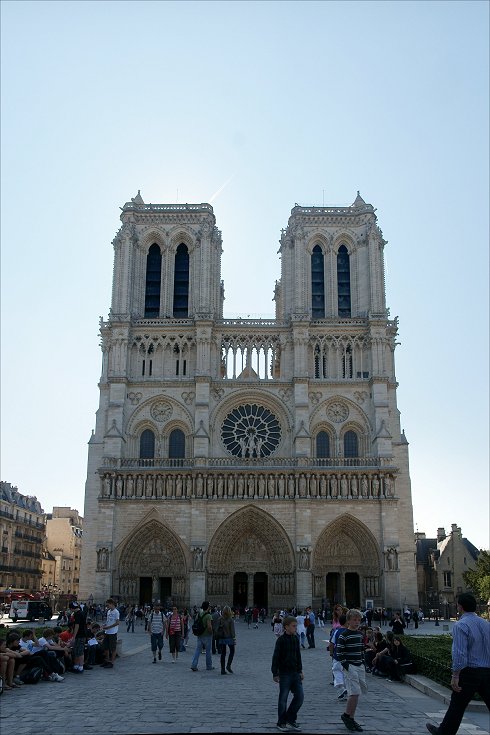
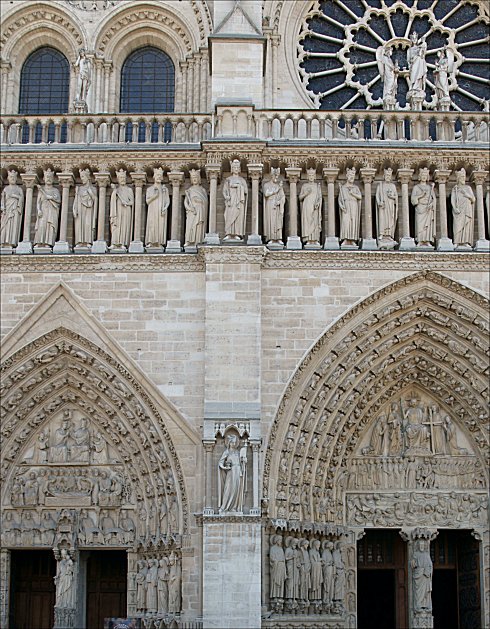
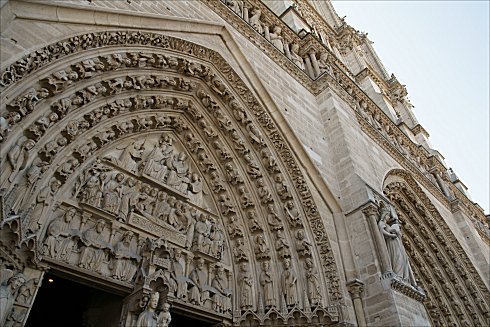
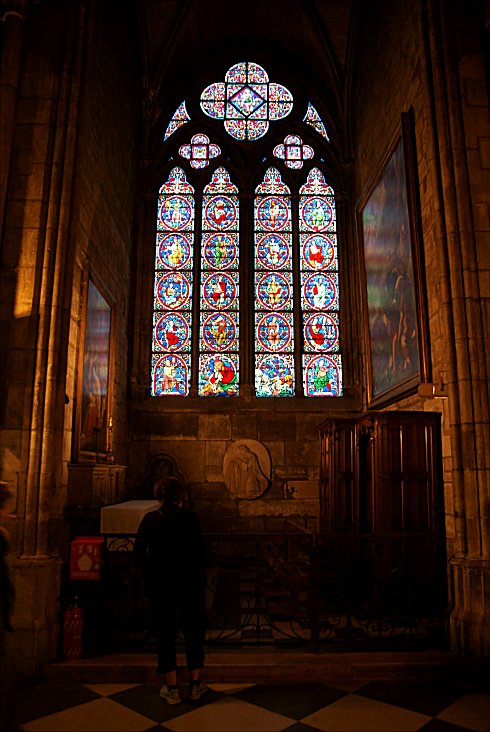



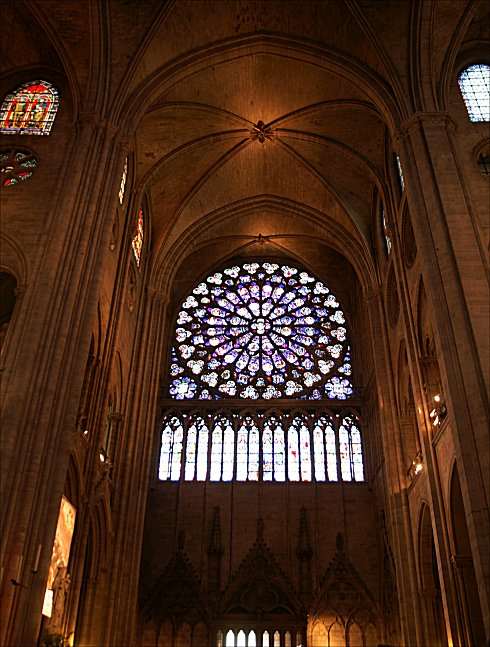
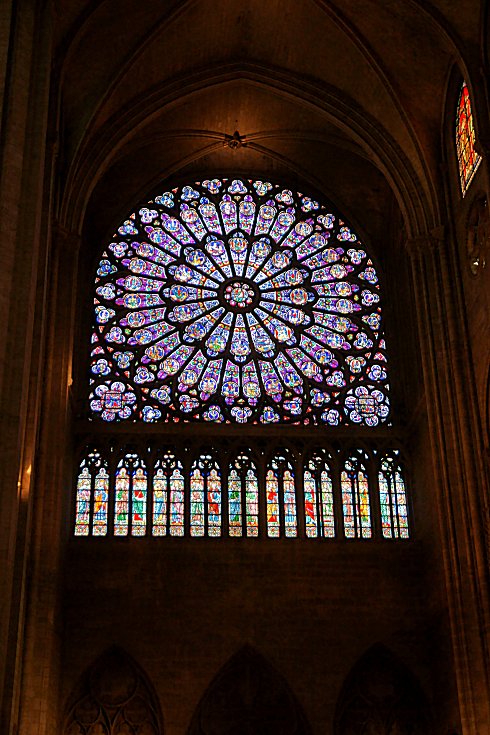
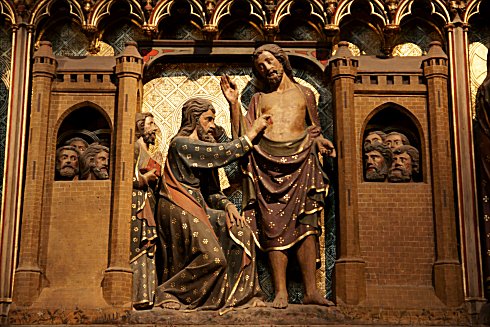
.jpg)
P h o t o s H a n s H e r m a n s
Cathédrale Notre Dame de Paris
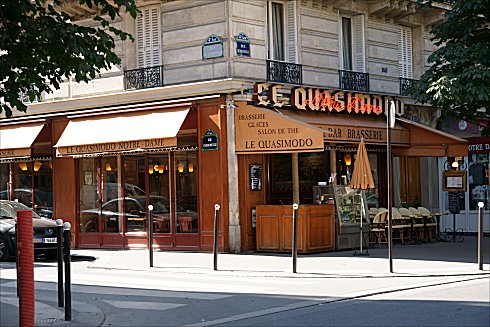
© hans hermans 2009
k e m p i s p o e t r y m a g a z i n e
More in: CATHEDRALS, FDM in Paris, Hans Hermans Photos, Victor Hugo
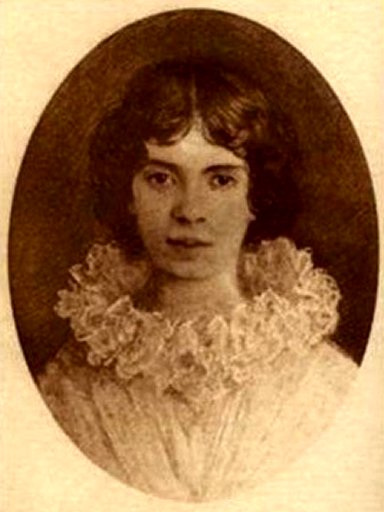
Emily Dickinson
(1830-1886)
I n a L i b r a r y
A precious, mouldering pleasure ‘t is
To meet an antique book,
In just the dress his century wore;
A privilege, I think,
His venerable hand to take,
And warming in our own,
A passage back, or two, to make
To times when he was young.
His quaint opinions to inspect,
His knowledge to unfold
On what concerns our mutual mind,
The literature of old;
What interested scholars most,
What competitions ran
When Plato was a certainty.
And Sophocles a man;
When Sappho was a living girl,
And Beatrice wore
The gown that Dante deified.
Facts, centuries before,
He traverses familiar,
As one should come to town
And tell you all your dreams were true;
He lived where dreams were sown.
His presence is enchantment,
You beg him not to go;
Old volumes shake their vellum heads
And tantalize, just so.
.jpg)
k e m p i s p o e t r y m a g a z i n e
More in: Dickinson, Emily, Libraries in Literature
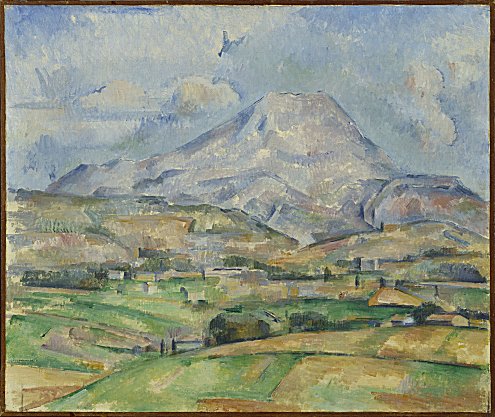
Paul Cézanne (1839-1906), La Montagne Sainte-Victoire, 1888, olieverf op doek, 83 x 72 cm,
collectie Stedelijk Museum Amsterdam, verworven met steun van de VVHK
GEMEENTEMUSEUM DEN HAAG
Cézanne – Picasso – Mondriaan
In nieuw perspectief
17 oktober 2009 t/m 24 januari 2010
Cézanne is de ‘vader van de moderne kunst’. Hij werd, hoe ironisch ook, vaak geweigerd op de Parijse salons, maar geldt nu als een van de belangrijkste kunstenaars van zijn periode. Picasso en Mondriaan zijn in zijn voetsporen getreden en gedrieën zijn zij verantwoordelijk voor misschien wel de meest beslissende ontwikkeling in de kunstgeschiedenis: het ontstaan van de abstracte kunst. Deze drie revolutionaire meesters zijn in het najaar van 2009 onderwerp van een grootse, internationale tentoonstelling in het Gemeentemuseum Den Haag. Hier wordt op spectaculaire wijze duidelijk gemaakt hoe de schilderkunst rond 1900 in een stroomversnelling raakte. Het resultaat is een boeiend verhaal waarin de toeschouwer wordt meegenomen van de zinnelijke en kleurrijke doeken van Cézanne via de felgekleurde – soms humoristische – werken van Picasso naar de uiterst subtiele schilderkunst van Mondriaan.
Geen andere laat-negentiende eeuwse kunstenaar had zoveel en zo’n blijvende invloed op zijn opvolgers als Paul Cézanne: met zijn subtiele kleurgevoel en zijn gedurfde composities brak hij een lans voor de generaties na hem. Voor het eerst sinds een halve eeuw is er weer werk van de Franse meester in ons land te zien, waaronder de wereldberoemde, sensuele Baadsters en de landschappen met de Mont Sainte-Victoire, bij het kleine dorpje Vauvenargues in de Franse Provence, als middelpunt.
Vanaf zijn komst naar Parijs, toen hij nauwelijks twintig jaar was, had Pablo Picasso tot aan het eind van zijn leven een grote bewondering voor Cézanne. Hij beschouwde zichzelf graag als diens (artistieke) zoon. Hij wilde zo graag in de voetsporen treden van zijn grote inspiratiebron, dat hij jaren later het kasteel, Château de Vauvenargues, betrok aan de voet van de Mont Sainte-Victoire. Het ging hem hierbij niet zozeer om een kunstzinnige navolging, maar echt om de fysieke plek waar Cézanne zijn werk had vervaardigd. Later, na zijn dood in 1973, zou Picasso er ook begraven worden.
Mondriaan was, vrijwel tegelijk met Picasso, ook bezig met zijn zoektocht naar het ideale kunstwerk. Hoewel hij uit de Nederlandse traditie komt waarin de Haagse School hoogtij vierde, had hij van jongs af aan veel interesse in de internationale schilderkunst. Zo haalde hij zijn opvatting van Kubisme in eerste instantie uit de krant. Een tentoonstelling over het kubisme in het Stedelijk Museum opende hem in 1911 definitief de ogen. Daar zag hij pas wat kubisme écht inhield en ontdekte hij de lijn die door Cézanne was ingezet en door Picasso werd doorgetrokken. Mondriaan besloot naar Parijs te gaan om de ontwikkelingen in de kunst met eigen ogen te zien. Van daaruit kwam hij een stap dichterbij de essentie van kleur en vorm. Het is voor het eerst dat de relatie van Mondriaan tot Picasso en Cézanne zo uitvoerig tegen het licht wordt gehouden.
Deze najaarstentoonstelling van het Gemeentemuseum geeft een uniek inzicht in de ontwikkeling van de moderne Westerse kunst waarin deze drie meesters ieder hun eigen baanbrekende rol hebben gespeeld. Met bijzondere bruiklenen van over de hele wereld, uit Washington (The National Gallery of Art), New York (The Metropolitan Museum of Modern Art) en Parijs (Centre Georges Pompidou) is deze tentoonstelling van grote kwaliteit.
Bij de tentoonstelling verschijnt een Nederlandstalige, rijk geïllustreerde catalogus met bijdragen van Hans Janssen, Franz-W. Kaiser, Brigitte Leal, Sylvie Patin, Anne Roquebert en Benno Tempel
Website Gemeentemuseum Den Haag
fleursdumal.nl magazine
More in: FDM Art Gallery, Pablo Picasso, Piet Mondriaan
.jpg)
Der Kaufmann
Franz Kafka (1883-1924)
Es ist möglich, daß einige Leute Mitleid mit mir haben, aber ich spüre nichts davon. Mein kleines Geschäft erfüllt mich mit Sorgen, die mich innen an Stirne und Schläfen schmerzen, aber ohne mir Zufriedenheit in Aussicht zu stellen, denn mein Geschäft ist klein.
Für Stunden im voraus muß ich Bestimmungen treffen, das Gedächtnis des Hausdieners wachhalten, vor befürchteten Fehlern warnen und in einer Jahreszeit die Moden der folgenden berechnen, nicht wie sie unter Leuten meines Kreises herrschen werden, sondern bei unzugänglichen Bevölkerungen auf dem Lande. Mein Geld haben fremde Leute; ihre Verhältnisse können mir nicht deutlich sein; das Unglück, das sie treffen könnte, ahne ich nicht; wie könnte ich es abwehren! Vielleicht sind sie verschwenderisch geworden und geben ein Fest in einem Wirtshausgarten und andere halten sich für ein Weilchen auf der Flucht nach Amerika bei diesem Feste auf.
Wenn nun am Abend eines Werketages das Geschäft gesperrt wird und ich plötzlich Stunden vor mir sehe, in denen ich für die ununterbrochenen Bedürfnisse meines Geschäftes nichts werde arbeiten können, dann wirft sich meine am Morgen weit vorausgeschickte Aufregung in mich, wie eine zurückkehrende Flut, hält es aber in mir nicht aus und ohne Ziel reißt sie mich mit. Und doch kann ich diese Laune gar nicht benützen und kann nur nach Hause gehn, denn ich habe Gesicht und Hände schmutzig und verschwitzt, das Kleid fleckig und staubig, die Geschäftsmütze auf dem Kopfe und von Kistennägeln zerkratzte Stiefel. Ich gehe dann wie auf Wellen, klappere mit den Fingern beider Hände und mir entgegenkommenden Kindern fahre ich über das Haar.
Aber der Weg ist zu kurz. Gleich bin ich in meinem Hause, öffne die Lifttür und trete ein. Ich sehe, daß ich jetzt und plötzlich allein bin. Andere, die über Treppen steigen müssen, ermüden dabei ein wenig, müssen mit eilig atmenden Lungen warten, bis man die Tür der Wohnung öffnen kommt, haben dabei einen Grund für Ärger und Ungeduld, kommen jetzt ins Vorzimmer, wo sie den Hut aufhängen, und erst bis sie durch den Gang an einigen Glastüren vorbei in ihr eigenes Zimmer kommen, sind sie allein. Ich aber bin gleich allein im Lift, und schaue, auf die Knie gestützt, in den schmalen Spiegel. Als der Lift sich zu heben anfängt, sage ich: »Seid still, tretet zurück, wollt Ihr in den Schatten der Bäume, hinter die Draperien der Fenster, in das Laubengewölbe?« Ich rede mit den Zähnen und die Treppengeländer gleiten an den Milchglasscheiben hinunter wie stürzendes Wasser. »Flieget weg; Euere Flügel, die ich niemals gesehen habe, mögen Euch ins dörfliche Tal tragen oder nach Paris, wenn es Euch dorthin treibt.
Doch genießet die Aussicht des Fensters, wenn die Prozessionen aus allen drei Straßen kommen, einander nicht ausweichen, durcheinander gehn und zwischen ihren letzten Reihen den freien Platz wieder entstehen lassen. Winket mit den Tüchern, seid entsetzt, seid gerührt, lobet die schöne Dame, die vorüberfährt.
Geht über den Bach auf der hölzernen Brücke, nickt den badenden Kindern zu und staunet über das Hurra der tausend Matrosen auf dem fernen Panzerschiff.
Verfolget nur den unscheinbaren Mann und wenn Ihr ihn in einen Torweg gestoßen habt, beraubt ihn und seht ihm dann, jeder die Hände in den Taschen, nach, wie er traurig seines Weges in die linke Gasse geht. Die verstreut auf ihren Pferden galoppierende Polizei bändigt die Tiere und drängt Euch zurück. Lasset sie, die leeren Gassen werden sie unglücklich machen, ich weiß es. Schon reiten sie, ich bitte, paarweise weg, langsam um die Straßenecken, fliegend über die Plätze.«
Dann muß ich aussteigen, den Aufzug hinunterlassen, an der Türglocke läuten, und das Mädchen öffnet die Tür, während ich grüße.
.jpg)
Franz Kafka: Betrachtung 1913 – Für M.B.
fleursdumal.nl magazine
More in: Franz Kafka, Kafka, Franz, Kafka, Franz
Thank you for reading Fleurs du Mal - magazine for art & literature